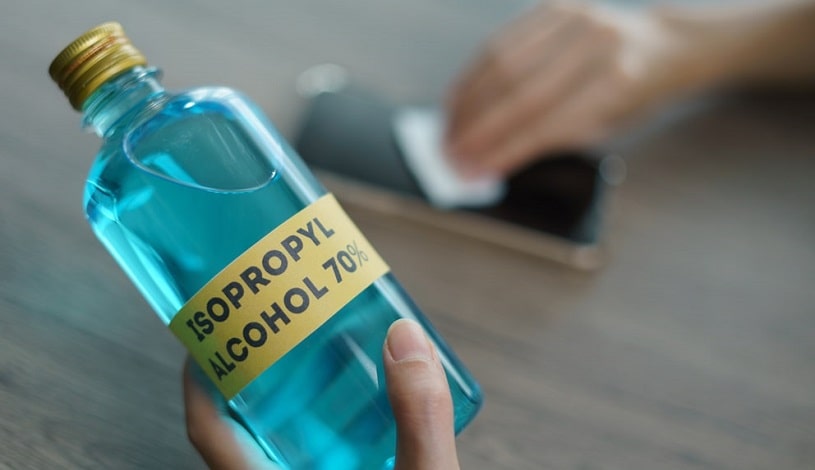It is not uncommon to find a bottle of isopropyl alcohol in a first-aid kit or medicine cabinet. Many people keep it on hand to disinfect minor cuts or clean household surfaces. However, some individuals start drinking rubbing alcohol with the hope of obtaining the same effects as consuming beer, wine, or liquor. Is drinking rubbing alcohol (IPA) safe? Can one overdose on it? What are the side effects? Let’s find out.
Table Of Contents:
What Is Isopropyl Alcohol?
Isopropanol is a colorless, flammable liquid that belongs to the same family of compounds as alcoholic drinks. It has a robust fruity odor and a mildly bitter taste. It is a volatile liquid, i.e., it evaporates if the container is left open. The structure of the substance is C3H8O. Other rubbing alcohol ingredients include water, denaturants, and perfume oils.
It is found in essential oils, body lotions, perfumes, medical swabs, paint thinners, antifreeze, and cleaning supplies.
Uses of The Substance
It is primarily used as a topical antiseptic because of its ability to kill harmful germs. Because it is a better solvent than water, it is handy in removing accumulated grime. It is present in swabs, hand sanitizers, household disinfectants, and cleaners. Isopropanol is also used in several industrial processes.
How Strong Is The Substance?
Medical antiseptic solutions commonly contain 70 percent concentration because this is not harsh to the skin but is still an effective antiseptic. Higher percentages, for example, 99% isopropyl alcohol, are used in household cleaning and disinfecting solutions.
Differences from Ethyl Alcohol
Alcoholic beverages contain ethanol which is produced from yeast. In isopropyl alcohol vs. ethanol comparison, one finds that the former is toxic when ingested while the latter is suitable to drink. Although it is also a volatile, colorless liquid, ethanol’s chemical formula is different (C2H6O), and it has a less intense odor compared to isopropanol.
Can You Drink Rubbing Alcohol?
Can you drink rubbing alcohol? The answer to this is not straightforward because while people drink the substance, it was not made to be ingested. Why then does one find people drinking isopropyl alcohol?

A major reason for the consumption of many harmful substances is the feeling of intoxication and euphoria that these substances provide to the user. Ethanol provides this intoxication at various levels depending on the consumer’s physiology and how much the person consumes.
However, for some people – especially those that have been drinking for a long time, the “high” that the substance provides soon becomes “not enough.” This brings the need to find something of a higher level to keep up with the dopamine levels that the brain has become accustomed to.
This is where another difference in isopropyl alcohol vs. ethanol comparison comes to play. The former is much stronger than the latter. It provides severe intoxication, and it is also very harmful, especially in the long-term. Some people go for isopropanol over ethanol because it is readily available and much cheaper to acquire. For context, a 16-ounce bottle of isopropanol costs only a little more than one dollar and can be easily purchased anytime at a 24-hour drug store.
Isopropanol is also more “quick-acting” than regular alcohol. This means that it is a more attractive proposition for people that are looking to get high immediately instead of waiting for the substance to settle into the bloodstream before results begin to show. Isopropanol gets absorbed into the bloodstream very quickly so that waiting time compared to ethanol is cut short.

These characteristics of isopropanol may present the substance as a go-to for an alcoholic looking for a more potent intoxication. Still, it is important to stress that some extreme risks and dangers come with using the substance.
Isopropanol is not intended for human consumption, and abuse can prove fatal. For context, 500 mL (a little more than a pint) of the substance ingested over a 24-hour period is the equivalent of drinking 30 beers. This can lead to isopropyl alcohol poisoning and possibly death if the resultant effects are not well-managed in a timely manner.
Circumstances Around Which a Person May Begin Drinking Rubbing Alcohol Include:
- Struggling with severe addiction. One may resort to extremes by consuming non-beverage alcohol such as aftershave, mouthwash, or hand sanitizer for intoxication
- Long-term alcoholics may develop a tolerance and want to drink more potent forms
- Underage persons who are not allowed to drink legally may seek a less regulated source
- Individuals with limited resources may try to become intoxicated on readily available and relatively inexpensive household products
- Young people and recreational drug users seeking a rapid and intense high
What Happens if You Drink Isopropyl Alcohol?
In the human body, isopropanol is oxidized in the liver to form a toxic chemical called acetone. It has a half-life of 2.5 to 8 hours (the time is taken for half the substance to be removed from the body by biological processes). The peak concentration following ingestion occurs within 30 minutes. It is removed from the body mainly through the kidneys.
The alcoholic beverages people drink are also metabolized by the liver but much more efficiently. They are broken down into acetaldehyde and acetate. One standard drink stays in the body for about 2 hours after ingestion. The effects become evident in 10 minutes, but peak concentration is reached in approximately one hour.
The obvious side effects of drinking rubbing alcohol may appear similar to that of ethanol. Still, the effects of the substance on the body are wildly different because they are far more dangerous. For one, even small quantities of isopropanol can be fatal because the substance is not made to be ingested in any form or manner.
Some of the More Severe Symptoms That May Present Themselves When Isopropanol Is Ingested Include:
- Difficulty breathing
- Low blood pressure
- Damage to the nervous system, stomach, and intestines
- Fatigue
- Blurred vision
In the direct effects of the substance on the body, one finds that the digestive tract goes through the most damage because isopropanol is a gastrointestinal irritant. Drinking rubbing alcohol can cause abdominal pain, nausea or cause the user to vomit blood. This occurs because the body metabolizes isopropanol into acetone. Acetone reacts on the digestive system negatively – hence the symptoms mentioned above.
Additionally, isopropanol is also a CNS depressant, and the direct result on the body is side effects such as headaches, dizziness, and inebriation. Classified into common and rare/severe, the side effects of consuming isopropanol are listed below.
Common Side Effects of Drinking Isopropyl Alcohol:
- Stomachaches
- Chest tightness
- Confusion
- Dizziness
- Sleepiness
- Headache
- Cold, clammy skin
- Diarrhea
- Vomiting
- Irritation of the eyes, throat, stomach, and intestines
- Abdominal pain
- Throat pain
- Lack of coordination
- Narrowed pupils
- Painfully reddened skin
- Too much or too little urine
- Wheezing
More Severe Effects of Drinking Isopropyl Alcohol:
- Ataxia (loss of control over bodily movements)
- Coma
- Brain damage
- Decreased function of the central nervous system, kidney, and liver
- Cornea burns and other damages
- Increased risk of stomach cancer
- Gastritis
- Gastrointestinal bleeding, hypothermia
- Low blood pressure
- Lactic acidosis
- Low blood sugar
- Slowed breathing
- Pancreatitis (inflammation of the pancreas)
- Tachycardia (increased heart rate)
- Stroke
- Heart attack
- Death
As suggested earlier, isopropanol consists of higher toxicity of harmful ingredients in comparison to regular alcohol. The substance has more molecular weight and can produce an altered sensorium, hypothermia, hypotension, and cardiopulmonary collapse. Hypotension, in particular, leads to the death of the affected person in nearly 45% of all cases.

Summarily, while isopropanol may provide a quick and more intoxicating high than ethanol, the risks and dangers far outweigh anything else. The substance is not made for consumption. However, the knowledge of this fact does not stop people from abusing isopropanol. Some users even find more ways to ingest the substance to achieve varied types of euphoria. One of such methods is by sniffing.
Sniffing Rubbing Alcohol
Other methods of abuse include huffing and sniffing of rubbing alcohol to inhale the vapors. Isopropyl alcohol inhalation can have several dangerous effects, including breathing difficulty and loss of consciousness. In addition to inhaling and drinking rubbing alcohol, spilling the substance on the skin can lead to accidental isopropyl alcohol poisoning. Repeated or prolonged exposure can cause itching, redness, and skin corrosion.
Isopropyl Alcohol Toxicity And Overdose
Is isopropyl alcohol toxic? Yes, it is about twice as toxic as the ethanol in beverages that are legal to drink. In fact, isopropyl alcohol poisoning can occur within 30-60 minutes of ingestion. It has serious effects such as slowed breathing, slowed heart rate, low blood pressure, low blood sugar, hypothermia, bleeding from the gastrointestinal tract, gastritis, brain damage, and coma.
A small bottle (about 8 ounces or 250 mL) of rubbing spirit ingested by mouth can prove lethal. If emergency medical attention is not provided to a person that overdoses, the chances of an occurrence of death are significantly increased.

To avoid situations like that, one needs to be aware of what exactly to do when dealing with a case of isopropyl alcohol poisoning. The first step is to call the emergency service number. The operator will then direct one to the nearest poison control center. If one has prior knowledge of the closest poison center, it will save time to reach out to the center straightaway instead.
When speaking to the operator at the poison control center, there are a couple of questions that are likely to be asked as they try to determine the situation.
These include:
- The amount of isopropyl ingested
- How much time has passed since the substance was ingested
- Any existing medical conditions
- The age, height, and weight of the person
- The specific symptoms that the person is exhibiting
One must make sure that any action carried out in a bid to help the poisoned person must only be done based on professional advice from a poison control specialist. Do not attempt to make the person vomit unless told to do so. If the person is struggling to swallow, trying to make them drink something will also only worsen the situation.
Depending on the severity of the situation, hospitalization may be required based on the advice of the position control center specialists.
Diagnosis and Treatment of Isopropyl Poisoning
At the hospital, a doctor will need to carry out a physical exam to check for signs of isopropyl alcohol poisoning.
Some Questions That May Come up During This Exam Include:
- How did the poisoning occur? Intentional ingestion or by accident?
- Which specific product was ingested?
- What medications is the person under?
- If the substance was ingested on purpose, what was the reason for it?
Depending on what the answers to these questions are, the doctor may order specific blood tests to be carried out. The doctor may also run an EKG to assess the functioning of the heart.
One or All of These Tests May Be Required:
- a complete blood count (CBC) (to check for signs of infection or blood cell damage)
- a toxicity panel (to determine the IPA concentration in the blood)
- a serum electrolyte level to check for signs of dehydration
After diagnosis, the next step is treatment.
There Are Three Common Approaches to Treating Isopropyl Abuse, and They Are:
- Oxygen therapy to help the lungs get rid of IPA faster
- Dialysis to remove IPA and acetone from the body
- If the doctor finds that the person is dehydrated, fluid replacement is a common treatment approach
Isopropyl poisoning is not always deliberate. Due to the fact that the substance is commonly found in many household products (cleaning products, paint thinners, perfumes, etc.), it is possible to ingest it by oversight or carelessness. To prevent this, one needs to keep such items away from the reach of children and also be careful when using them. For instance, it is a good safety measure to wear gloves when using cleaning agents.
Beating Addiction to Rubbing Alcohol
There is a tremendous risk of injury and death from isopropyl alcohol poisoning, and individuals who have consumed this substance require aggressive medical care and life support measures. As suggested previously, the best approach to treating isopropyl poisoning and consequently beating the addiction (if it applies) is through professional intervention.
If one is dealing with isopropanol addiction or suspects that a loved one is, the best form of help that can be sought is through professionals at a reputed rehabilitation facility. These health professionals will not only help addicts recover from alcohol abuse, but they can also provide measures that will help avoid relapse to the habit.
Hope Without Commitment
Find the best treatment options. Call our free and confidential helpline
Most private insurances accepted
Page Sources
- Slaughter, R. J., Mason, R. W., Beasley, D. M. G., Vale, J. A., & Schep, L. J. (2014). Isopropanol poisoning. Clinical toxicology, 52(5), 470-478. https://www.ncbi.nlm.nih.gov/pubmed/24815348
- National Research Council (U. (1984). Emergency And Continuous Exposure Limits For Selected Airborne Contaminants Volume 2 (Vol. 1). National Academies Press. https://www.ncbi.nlm.nih.gov/books/NBK208299/
- Ashurst, J. V., & Nappe, T. M. (2019). Isopropanol toxicity. StatPearls [Internet]. https://www.ncbi.nlm.nih.gov/books/NBK493181/
- New Jersey Department of Health (2016). Hazardous Substance Fact Sheet: Isopropyl Alcohol. https://www.nj.gov/health/eoh/rtkweb/documents/fs/1076.pdf
- Foucher, C. D., & Tubben, R. E. (2020). Lactic acidosis. StatPearls [Internet]. https://www.ncbi.nlm.nih.gov/books/NBK470202/
- Mecikalski, M. B., & Depner, T. A. (1982). Peritoneal dialysis for isopropanol poisoning. Western Journal of Medicine, 137(4), 322. https://www.ncbi.nlm.nih.gov/pmc/articles/PMC1274122/
- Adelson, L. (1962). Fatal intoxication with isopropyl alcohol (rubbing alcohol). American journal of clinical pathology, 38(2), 144-151. https://academic.oup.com/ajcp/article-abstract/38/2/144/1763010
- Daniel, D. R., McAnalley, B. H., & Garriott, J. C. (1981). Isopropyl alcohol metabolism after acute intoxication in humans. Journal of analytical toxicology, 5(3), 110-112. https://academic.oup.com/jat/article-abstract/5/3/110/769900




